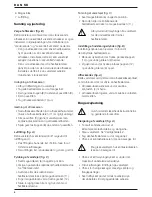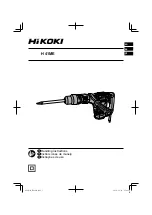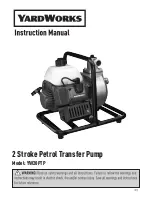
19
E N G L I S H
Safety instructions
When using tools, always observe the safety
regulations applicable in your country to reduce
the risk of personal injury. Read the following
safety instructions before attempting to operate
this product.
Keep these instructions in a safe place!
General
1 Keep work area clean
Cluttered areas and benches can cause accidents.
2 Consider work area environment
Do not expose tools to humidity. Keep work area
well lit. Do not use tools in the presence of
flammable liquids or gases.
3 Keep children away
Do not let children or visitors come into contact
with the tool. Supervision is required for those
under 16 years of age.
4 Store idle tools
When not in use, tools must be stored in a dry
place and locked up securely, out of reach of
children.
5 Dress properly
Do not wear loose clothing or jewellery. They can
be caught in moving parts. Preferably wear
rubber gloves and non-slip footwear when
working outdoors. Wear protective hair covering
to keep long hair out of the way.
6 Do not overreach
Keep proper footing and balance at all times.
7 Stay alert
Watch what you are doing. Use common sense.
Do not operate the tool when you are tired.
8 Use appropriate tool
The intended use is described in this instruction
manual. Do not force small tools or attachments
to do the job of a heavy-duty tool. The tool will
do the job better and safer at the rate for which it
was intended.
Warning!
The use of any accessory or attachment
or performance of any operation with this tool,
other than those recommended in this instruction
manual may present a risk of personal injury.
9 Maintain tools with care
Keep the tools in good condition and clean for
better and safer performance.
Follow the instructions for maintenance and
changing accessories. Keep all controls dry,
clean and free from oil and grease.
10 Check for damaged parts
Before using the tool, carefully check it for
damage to ensure that it will operate properly
and perform its intended function. Check for
misalignment and seizure of moving parts,
breakage of parts and any other conditions that
may affect its operation. Have damaged guards
or other defective parts repaired or replaced as
instructed.
11 Have your tool repaired by an authorized
D
E
WALT repair agent
This tool is in accordance with the relevant safety
regulations. To avoid danger, tools must only be
repaired by qualified technicians.
Additional safety instructions for pneumatic tools
• Use quick-action couplings for connection to the
compressed air system. The non-sealable nipple
must be fitted to the tool in such a way that no
compressed air remains in the tool after
disconnection.
• Always use clean, dry compressed air. Do not
use oxygen or combustible gases as an energy
source for this tool.
• Only connect this tool to an air supply where the
maximum allowable pressure of the tool cannot
be exceeded by more than 10%. In case of
higher pressures, a pressure reducing valve
including a downstream safety valve shall be built
into the compressed air supply.
• Only use hoses with a rating exceeding the
maximum operating pressure of the tool.
• Before transporting the tool, disconnect it from
the compressed air system, especially where
ladders are used or where unusual physical
posture is adopted while moving.
• Disconnect the tool from the air supply when it is
not in use.
Additional safety instructions for fastener driving
tools
• Always wear safety glasses.
• Always wear ear protection.
• Never load fasteners with the trigger activated.
• Only use fasteners of the type specified in the
manual.
Summary of Contents for D51430
Page 1: ...1 D51430 D51431 ...
Page 3: ...3 7 4 5 1 2 6 3 A ...
Page 4: ...4 15 14 13 12 3 8 9 11 10 B D E 6 11 C ...
Page 90: ...90 ...
Page 91: ...91 ...
















































